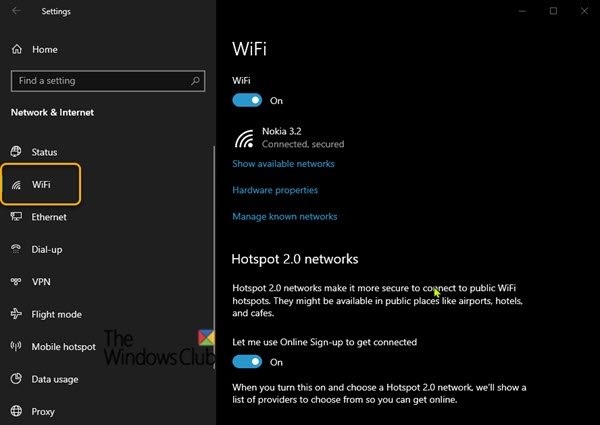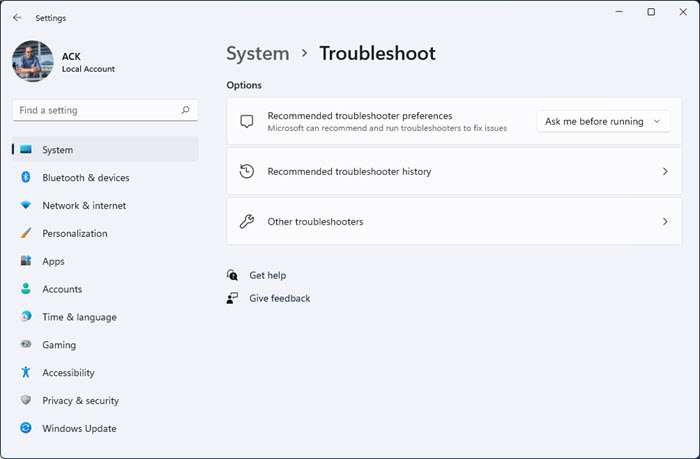In today’s post, we will explore the possible solutions to the issue of Wi-Fi settings are missing on your Surface or Windows 11/10 device. Before trying any of the solutions that will be outlined in this post, make sure that the symptoms you have are the same as those described.
Wi-Fi Settings are missing on Windows or Surface device
Before you begin, check the Network & Internet settings on your Windows 11/10 device.

Select Start > Settings > Network & Internet.
You won’t be able to connect to a wireless network if Wi-Fi is not listed in Network & Internet. If Wi-Fi is missing, the Internet access icon will also be missing from your taskbar.
Below are some solutions to try in no particular order if you can’t connect to a wireless network because Wi-Fi settings aren’t visible on your Surface or Windows device.
- Restart your Surface or Windows device and check Wi-Fi settings
- Install Windows Updates
- Run the Windows Network Troubleshooter
- Verify that Wi-Fi is available in Device Manager.
Now, let’s delve into the details of these recommended solutions.
1] Restart your Surface or Windows and check Wi-Fi settings
If your Wi-Fi settings are missing, restart (not shut down) your Surface or Windows device, and check the Wi-Fi settings again.
Here’s how:
- Make sure your router is connected to a working phone jack or cable connection, either directly or through a modem.
- Select Start > Power > Restart, or if you have updates pending, select Update and restart.
- After your Surface or Windows 10 device restarts, sign in.
- Select Start > Settings > Network & Internet .
- Select Airplane mode, and make sure Airplane mode is set to Off.
If Wi-Fi settings are visible, select Wi-Fi and make sure that Wi-Fi is set to On and that your network name appears in the list of available wireless networks. Select your network, and then select Connect.
If Wi-Fi settings are still missing, proceed with the next solution.
Read: Surface device finds available wireless network but won’t connect
2] Install Windows Updates
Installing the latest updates can help fix many common Wi-Fi connection issues, but you’ll need to be online to download updates.
If you can’t connect to your home network or to a public wireless network at a coffee shop or library, here are other ways that you may be able to go online and get the updates:
- You can go online using a wired connection (for example, an Ethernet-to-USB adapter or the Surface dock and Ethernet).
- You can download a single update file manually to install them. You can use another PC with internet access to download the file to a USB drive and transfer it to your Surface.
- If you have a Surface with built-in mobile broadband connectivity, you can use it to connect to the internet and get updates.
Once you’re online, you can then check for and install the latest updates manually.
Here’s how:
- Select Start > Settings > Update & Security > Windows Update.
- Select Check for updates. If updates are available, they will download and install automatically.
- After the updates are installed, if your device doesn’t restart automatically, you can do it manually: Select Start > Power > Restart, or if you have updates pending, select Update and restart.
- After your device restarts, sign in.
- Repeat these steps until you see Your device is up to date after you select Check for updates.
Read: Slow WiFi connection speed on Surface Pro or Surface Book
3] Run the Windows Network Troubleshooter

Here’s how to run the Windows Network Troubleshooter that can help diagnose and fix Wi-Fi problems.
Select the Start button, and then select Settings > Network & Internet > Status > Network troubleshooter, and choose from the options.
4] Verify that Wi-Fi is available in Device Manager
In some cases, Wi-Fi may be disabled in Device Manager if Wi-Fi settings are missing on your Surface.
Here’s how to verify that Wi-Fi is available in Device Manager on your Surface or Windows device.
- In the search box in the taskbar, enter Device Manager, and select it from the results.
- Select the arrow next to Network adapters to expand the adapters list, and check to see if one of the following adapters is listed in the table below:
| Network Controller/Adapter | Surface device used in |
|---|---|
| Intel® Wi-Fi 6 AX201 | Surface Laptop 3 (15 in. with Intel), Surface Laptop 3 (13.5 in.), and Surface Pro 7 |
| Qualcomm Atheros QCA61x4A Wireless Network Adapter | Surface Go, Surface Laptop 3 (15 in. with AMD), and Surface Pro X |
| Marvell AVASTAR Network Controller | All other Surface devices |
The name of the network controller may be slightly different depending on your Surface model.
- Double-click the respective Network Controller or Adapter, select the Driver tab, and then select Disable Device.
- In the warning box, select Yes.
- Then restart the network controller by selecting Enable Device.
- Restart your Surface by selecting Start > Power > Restart, or if you have updates pending, select Update and restart.
Need more suggestions? Refer to our post titled Fix Network & Internet connection problems.
Leave a Reply